The Role of Naturally Occurring Fe(II) in Removing Arsenic from Groundwater: Batch Experiments and Field Studies
Abstract
:1. Introduction
2. Materials and Methods
2.1. Clay Filters and Field Experiments
2.2. Reagents and Synthetic Groundwater
2.3. Batch Experiments
2.4. Analytical Methods
2.5. X-ray Absorption Fine Structure (XAFS) Analysis
3. Results and Discussion
3.1. Groundwater Quality
3.2. As and Fe Removal Using Clay Filters
3.3. Laboratory Batch Experiments
3.4. Mechanisms of As(III) and As(V) Removal Using Fe(II)
4. Conclusions
Author Contributions
Funding
Data Availability Statement
Acknowledgments
Conflicts of Interest
References
- Abernathy, C.O.; Thomas, D.J.; Calderon, R.L. Health effects and risk assessment of arsenic. J. Nutr. 2003, 133, 1536–1538. [Google Scholar] [CrossRef]
- Bloom, M.S.; Fitzgerald, E.F.; Kim, K.; Neamtiu, I.; Gurzau, E.S. Spontaneous pregnancy loss in humans and exposure to arsenic in drinking water. Int. J. Hyg. Environ. Health 2010, 213, 401–413. [Google Scholar] [CrossRef]
- WHO. World Health Organization, Guidelines for drinking-water quality. In Health Criteria and Other Supporting Information, 4th ed.; WHO: Geneva, Switzerland, 2011. [Google Scholar]
- BGS; DPHE. Arsenic Contamination of Groundwater in Bangladesh; British Geological Survey Technical Report WC/00/19; Kinniburgh, D.G., Smedley, P.L., Eds.; British Geological Survey: Nottinghamshire, UK, 2001. [Google Scholar]
- Acharyya, S.K.; Chakraborty, P.; Lahiri, S.; Raymahashay, B.C.; Guha, S.; Bhowmik, A. Arsenic poisoning in the Ganges delta. Nature 1999, 401, 545. [Google Scholar] [CrossRef]
- Katsoyiannis, I.A.; Ruettimann, T.; Hug, S.J. pH dependence of Fenton reagent generation and As(III) oxidation and removal by corrosion of zero valent iron in aerated water. Environ. Sci. Technol. 2008, 42, 7424–7430. [Google Scholar] [CrossRef]
- Shafiquzzaman, M.; Mishima, I.; Nakajima, J. Arsenic removal from groundwater by sand filtration during biological iron oxidation. Jpn. J. Water Treat. Biol. 2008, 44, 11–20. [Google Scholar] [CrossRef]
- Ahmad, A.; Cornelissen, E.; van de Wetering, S.; van Dijk, T.; van Genuchten, C.; Bundschuh, J.; van der Wal, A.; Bhattacharya, P. Arsenite removal in groundwater treatment plants by sequential Permanganate-Ferric treatment. J. Water Process Eng. 2018, 26, 221–229. [Google Scholar] [CrossRef]
- Sorlini, S.; Gialdini, F. Conventional oxidation treatments for the removal of arsenic with chlorine dioxide, hypochlorite, potassium permanganate and monochloramine. Water Res. 2010, 44, 5653–5659. [Google Scholar] [CrossRef]
- Giles, D.; Mohapatra, M.; Issa, T.; Anand, S.; Singh, P. Iron and aluminium based adsorption strategies for removing arsenic from drinking water. J. Environ. Manag. 2011, 92, 3011–3022. [Google Scholar] [CrossRef]
- Kalarubana, M.; Loganathana, P.; Nguyena, T.V.; Nura, T.; Johira, M.A.H.; Nguyenb, T.H.; Trinhb, M.V.; Vigneswarana, S. Iron-impregnated granular activated carbon for arsenic removal: Application to practical column filters. J. Environ. Manag. 2019, 239, 235–243. [Google Scholar] [CrossRef]
- Ortega, A.; Oliva, I.; Contreras, K.E.; González, I.; Cruz-Díaz, M.R.; Rivero, E.P. Arsenic removal from water by hybrid electro-regenerated anion exchange resin/electrodialysis process. Sep. Purifi. Technol. 2017, 184, 319–326. [Google Scholar] [CrossRef]
- Chiavola, A.; Amato, E.D.; Sirini, P.; Caretti, C.; Gori, R. Arsenic Removal from a Highly Contaminated Groundwater by a Combined Coagulation-Filtration-Adsorption Process. Water Air Soil. Pollut. 2019, 230, 87. [Google Scholar] [CrossRef]
- Lakshmanan, D.; Clifford, D.; Samanta, G. Arsenic removal by coagulation: With aluminum, iron, titanium, and zirconium. Am. Water Work. Assoc. 2008, 100, 76. [Google Scholar] [CrossRef]
- Tanne, N.; Xu, R.; Zhou, M.; Zhang, P.; Wang, X.; Wen, X. Influence of pore size and membrane surface properties on arsenic removal by nanofiltration membranes. Front. Environ. Sci. Eng. 2019, 13, 19. [Google Scholar] [CrossRef]
- Mendoza, R.M.O.; Kan, C.-C.; Chuang, S.-S.; Pingul-Ong, S.M.B.; Dalida, M.L.P.; Wan, M.-W. Feasibility studies on arsenic removal from aqueous solutions by electrodialysis. J. Environ. Sci. Health Part A Toxic Hazard. Subst. Environ. Eng. 2014, 49, 545–554. [Google Scholar] [CrossRef]
- Razzak, A.; Shafiquzzaman, M.; Haider, H.; Alresheedi, M. Arsenic removal by iron-oxidizing bacteria in a fixed-bed coconut husk column: Experimental study and numerical modeling. Environ. Pollut. 2021, 272, 115977. [Google Scholar] [CrossRef]
- Mohan, D.; Pittman, C.U., Jr. Arsenic removal from water/wastewater using adsorbents—A critical review. J. Hazard. Mater. 2007, 142, 1–53. [Google Scholar] [CrossRef]
- Jang, M.; Chen, W.; Cannon, F. Preloading hydrous ferric oxide into granular activated carbon for arsenic removal. Environ. Sci. Technol. 2008, 42, 3369–3374. [Google Scholar] [CrossRef]
- Anjum, A.; Lokeswari, P.; Kaur, M.; Datta, M. Removal of As(III) from aqueous solution using montmorillonite. J. Chromatogr. B 2011, 1, 25–30. [Google Scholar] [CrossRef]
- Singh, R.; Singh, S.; Parihar, P.; Singh, V.; Prasad, S. Arsenic contamination, consequences and remediation techniques: A review. Ecotoxicol. Environ. Saf. 2015, 112, 247–270. [Google Scholar] [CrossRef]
- Roberts, L.C.; Hug, S.J.; Ruettimann, T.; Billah, M.M.; Khan, A.W.; Rahman, M. Arsenic Removal with Iron(II) and Iron(III) in Waters with High Silicate and Phosphate Concentrations. Environ. Sci. Technol. 2004, 38, 307–315. [Google Scholar] [CrossRef]
- Guan, X.; Dong, H.; Ma, J.; Jiang, L. Removal of arsenic from water: Effects of competing anions on As(III) removal in KMnO4-Fe(II) process. Water Res. 2009, 43, 3891–3899. [Google Scholar] [CrossRef]
- Guan, X.; Dong, H.; Ma, J.; Jiang, L. Removal of arsenic from water: Effect of calcium ions on As(III) removal in the KMnO4-Fe(II) process. Water Res. 2009, 43, 5119–5128. [Google Scholar] [CrossRef]
- Shafiquzzaman, M.; Hasan, M.M.; Haider, H.; Bari, Q.H.; EL-Ghoul, Y.; Nakajima, J. Arsenic removal by household-based ceramic filters: Evaluating mode of operations and influence of groundwater compositions. J. Water Proc. Eng. 2022, 46, 102598. [Google Scholar] [CrossRef]
- Mueller, B.; Dangol, B.; Ngai, T.K.K.; Hug, S.J. Kanchan arsenic filters in the lowlands of Nepal: Mode of operation, arsenic removal, and future improvements. Environ. Geochem. Health 2021, 43, 375–389. [Google Scholar] [CrossRef]
- Neumann, A.; Kaegi, R.; Voegelin, A.; Hussam, A.; Munir, A.K.M.; Hug, S.J. Arsenic removal with composite iron matrix filters in Bangladesh: A field and laboratory study. Environ. Sci. Technol. 2013, 47, 4544–4554. [Google Scholar] [CrossRef]
- Hasan, M.M.; Shafiquzzaman, M.; Nakajima, J.; Bari, Q.H. Application of a simple arsenic removal filter in a rural area of Bangladesh. Water Sci. Technol. Water Supply 2012, 12, 658–665. [Google Scholar] [CrossRef]
- APHA. Standard Methods for the Examination of Water and Wastewater; American Public Health Association (APHA): Washington, DC, USA, 2005. [Google Scholar]
- Haque, K.E. Geochemical assessment of groundwater in the foothills area of Siliguri, Darjeeling District, India. Int. J. Earth Sci. Eng. 2009, 2, 135–144. [Google Scholar]
- Al-Abed, S.; Jegadeesan, G.; Purandare, J.; Allen, D. Arsenic release from iron-rich mineral processing waste: Influence of ph and redox potential. Chemosphere 2007, 66, 775–782. [Google Scholar] [CrossRef]
- Smedley, P.L.; Kinniburgh, D.G. A review of the source, behavior and distribution of arsenic in natural waters. Appl. Geochem. 2002, 17, 517–568. [Google Scholar] [CrossRef]
- Tabelin, C.B.; Igarashi, T.; Tabelin, M.V.; Park, I.; Opiso, E.M.; Ito, M.; Hiroyoshia, N. Arsenic, selenium, boron, lead, cadmium, copper, and zinc in naturally contaminated rocks: A review of their sources, modes of enrichment, mechanisms of release, and mitigation strategies. Sci. Total Environ. 2018, 645, 1522–1553. [Google Scholar] [CrossRef]
- USEPA. Drinking Water Health Advisory for Manganese. 2004. Available online: https://www.epa.gov/sites/production/files/2014-09/documents/support_cc1_magnese_dwreport_0.pdf (accessed on 25 October 2023).
- Saha, S.; Reza, A.H.M.S.; Roy, M.K. Hydrochemical evaluation of groundwater quality of the Tista floodplain, Rangpur, Bangladesh. Appl. Water Sci. 2019, 9, 198. [Google Scholar] [CrossRef]
- Ahmad, A.; Rutten, S.; Eikelboom, M.; Waal, L.; Bruning, H.; Bhattacharya, P.; van der Wal, A. Impact of Phosphate, silicate, and natural organic matter on the size of Fe(III) precipitates and arsenate coprecipitation efficiency in calcium-containing water. Sep. Purific. Technol. 2020, 235, 116117. [Google Scholar] [CrossRef]
- Ciardelli, M.C.; Xu, H.; Sahai, N. Role of Fe(II), phosphate, silicate, sulfate, and carbonate in arsenic uptake by coprecipitation in synthetic and natural groundwater. Water Res. 2008, 42, 615–624. [Google Scholar] [CrossRef]
- Mercer, K.L.; Tobiason, J.E. Removal of arsenic from high ionic strength solutions: Effects of ionic strength, pH, and preformed versus in situ formed HFO. Environ. Sci. Technol. 2008, 42, 3797–3802. [Google Scholar] [CrossRef]
- Wagner, F.; Berner, Z.; Stüben, D. Natural Arsenic in Groundwater: Occurrences, Remediation and Management; Bundschuh, J., Bhattacharya, P., Chandrasekharam, D., Eds.; Taylor & Francis, Balkema: London, UK, 2005; pp. 3–15. [Google Scholar]
- Wang, Y.; Morin, G.; Ona-Nguema, G.; Juillot, F.; Guyot, F.; Calas, G.; Brown, G.E., Jr. Evidence for Different Surface Speciation of Arsenite and Arsenate on Green Rust: An EXAFS and XANES Study, Environ. Sci. Technol. 2010, 44, 109–115. [Google Scholar] [CrossRef]

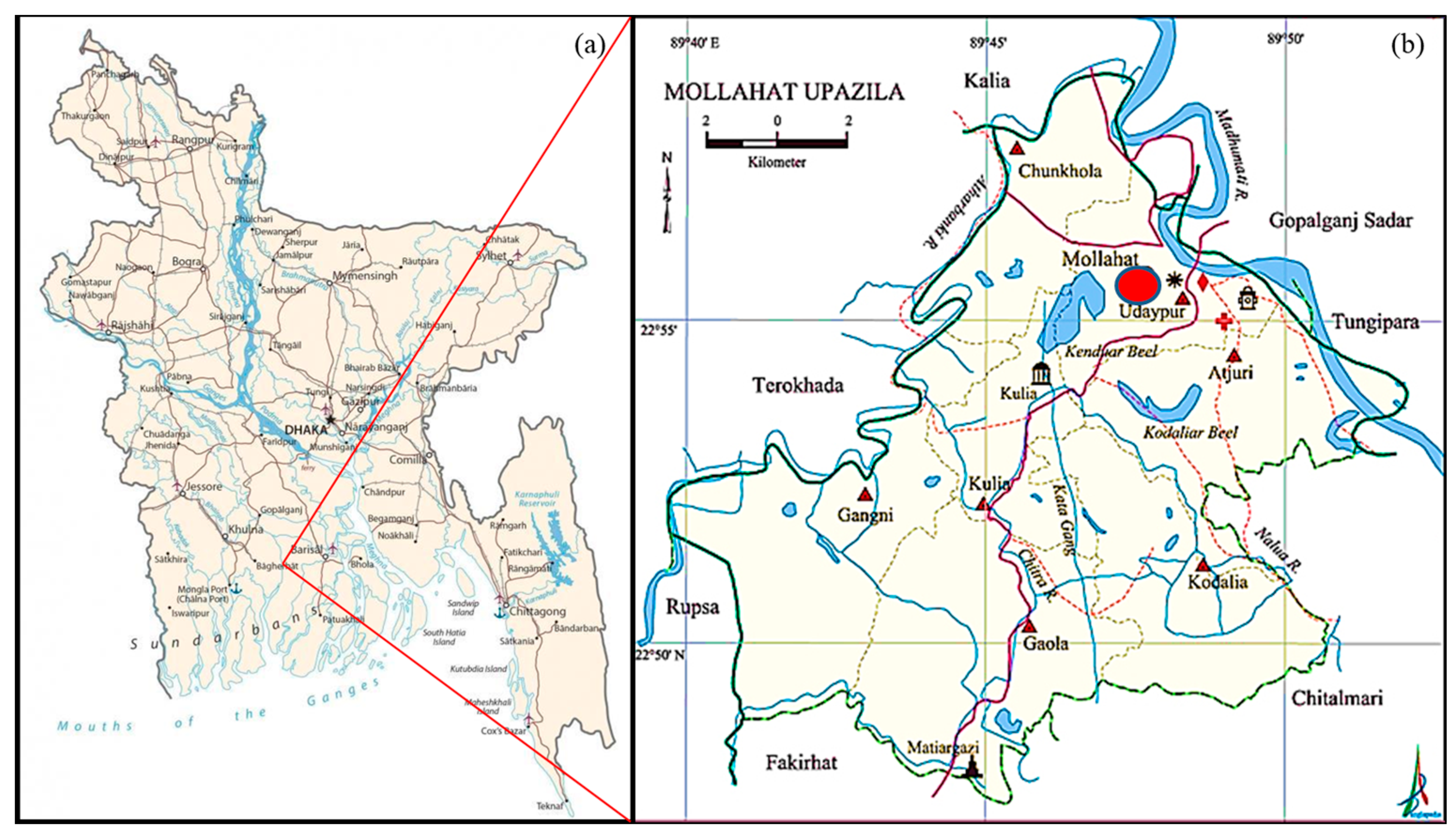
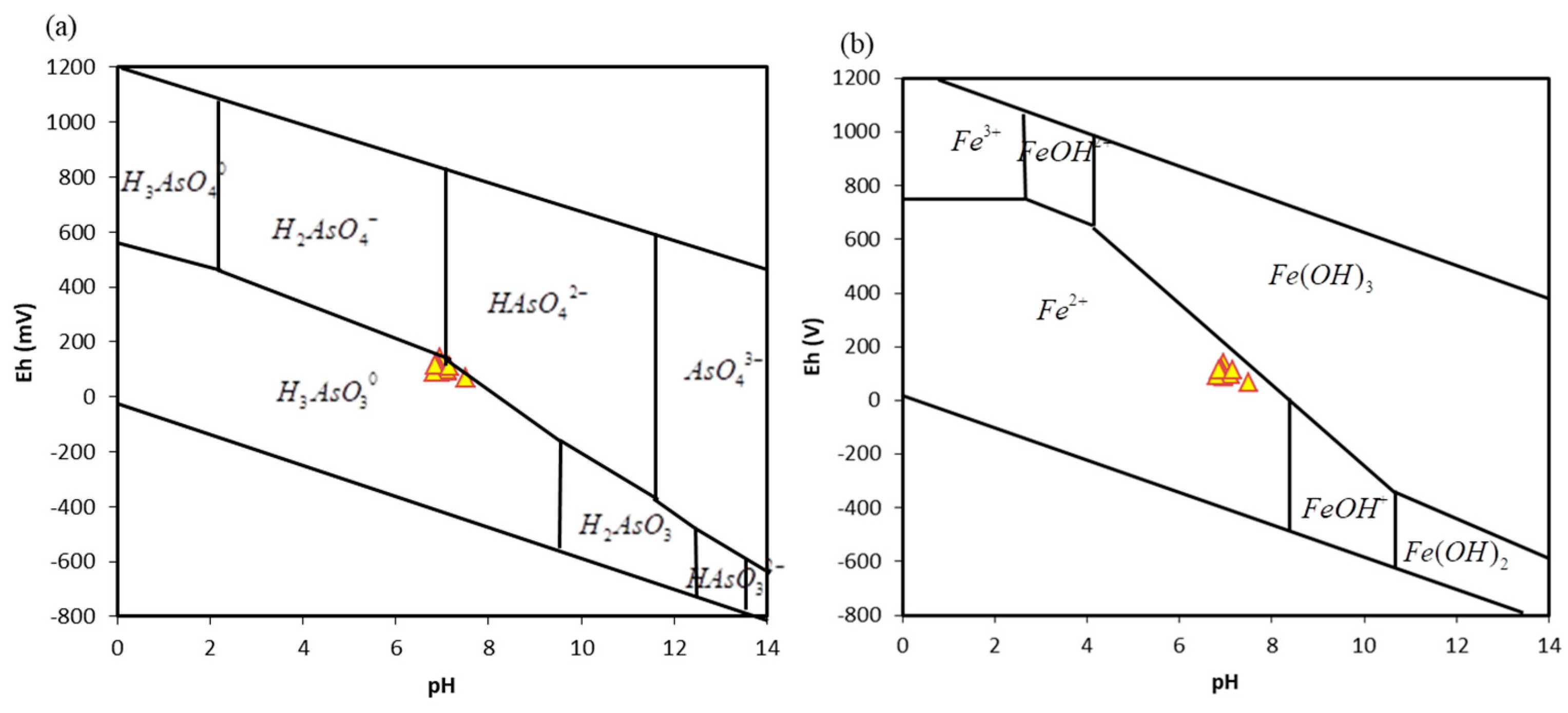
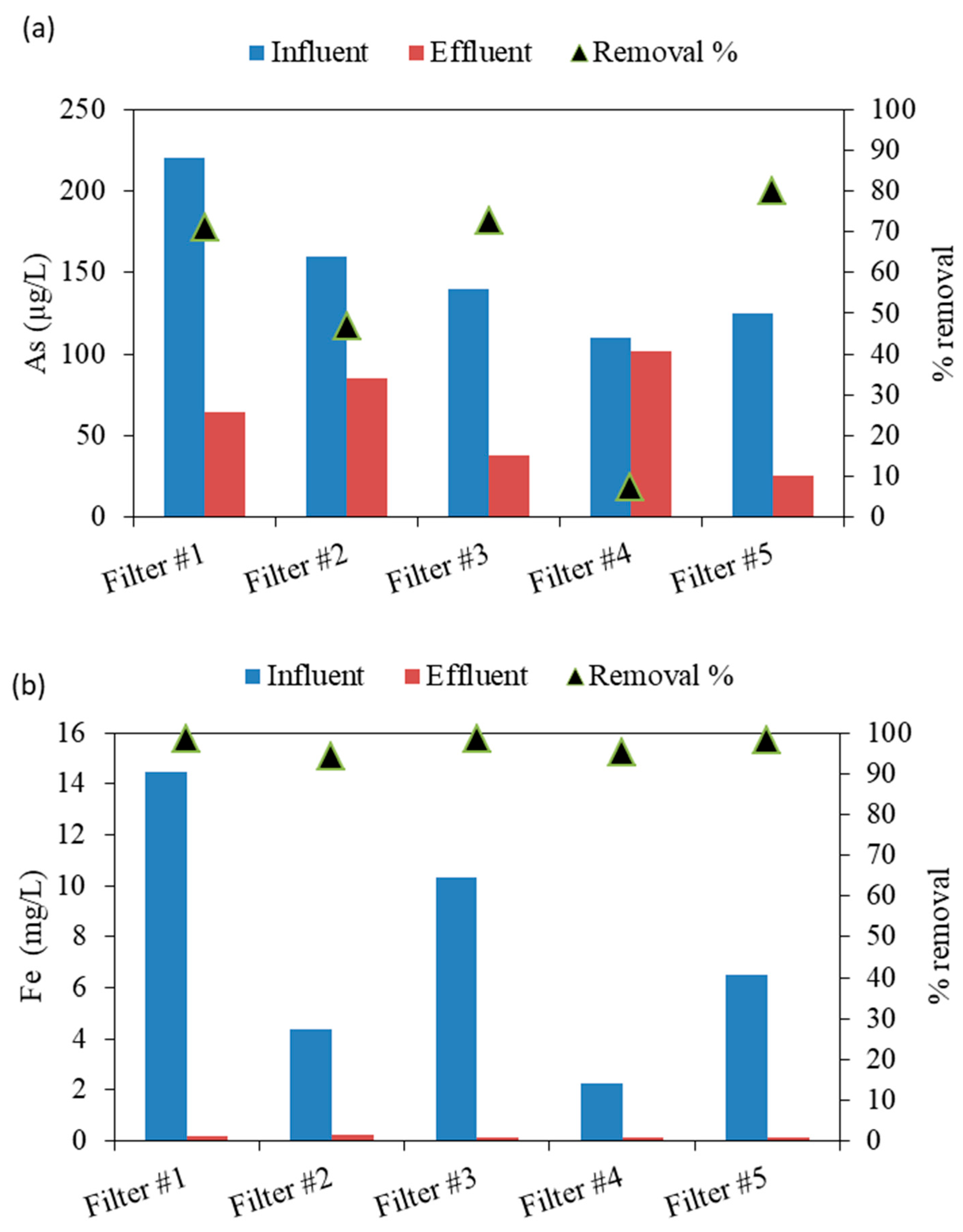
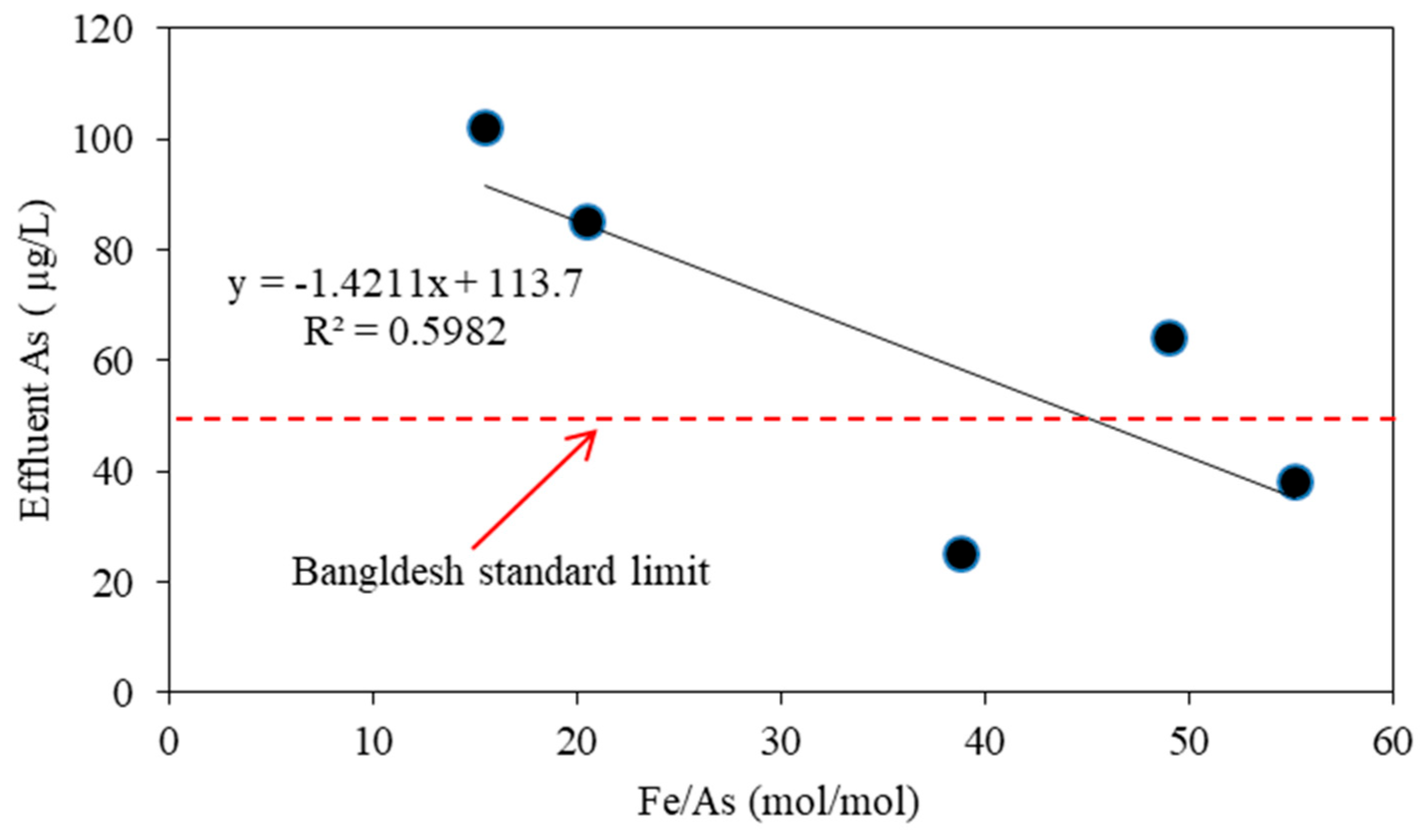
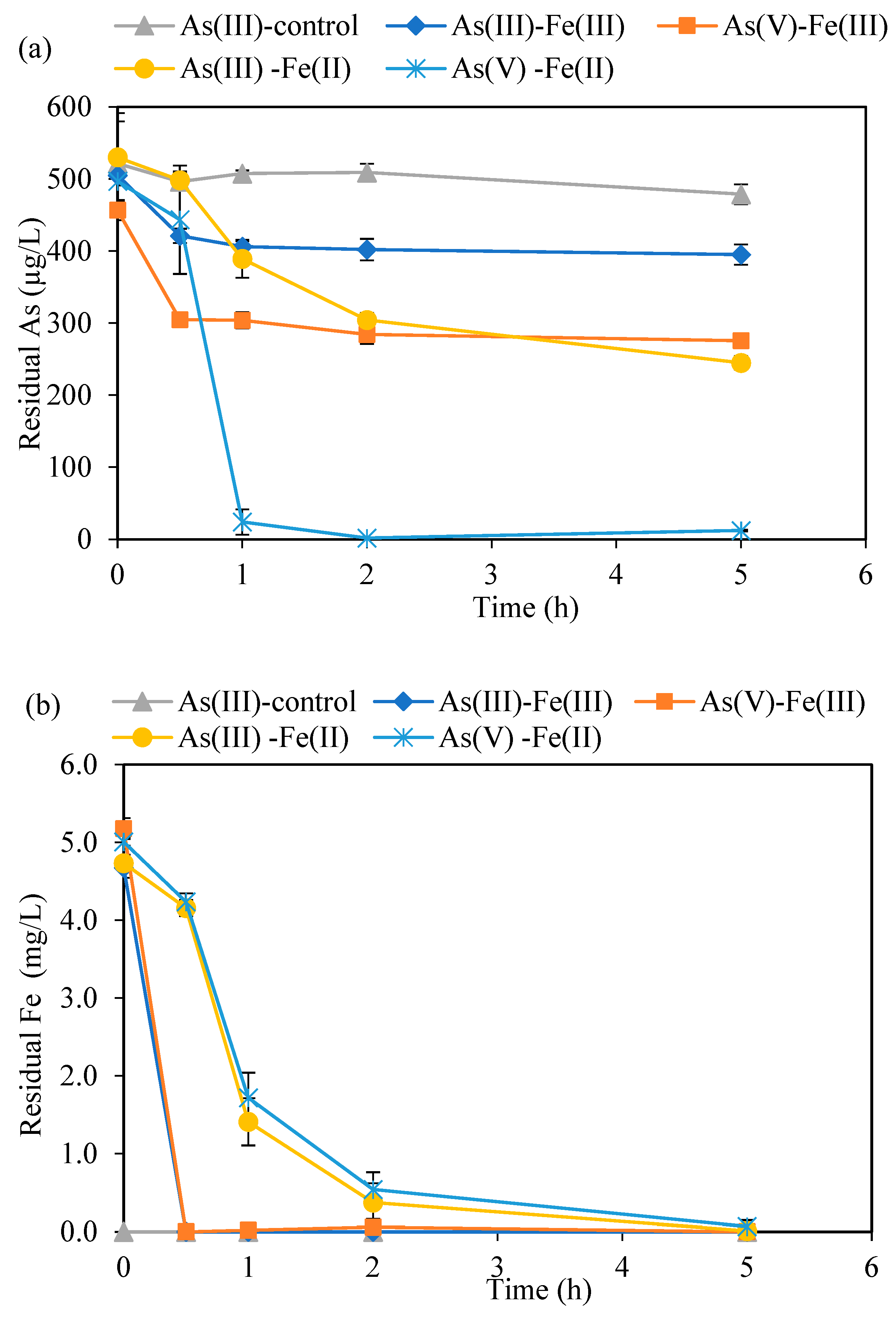
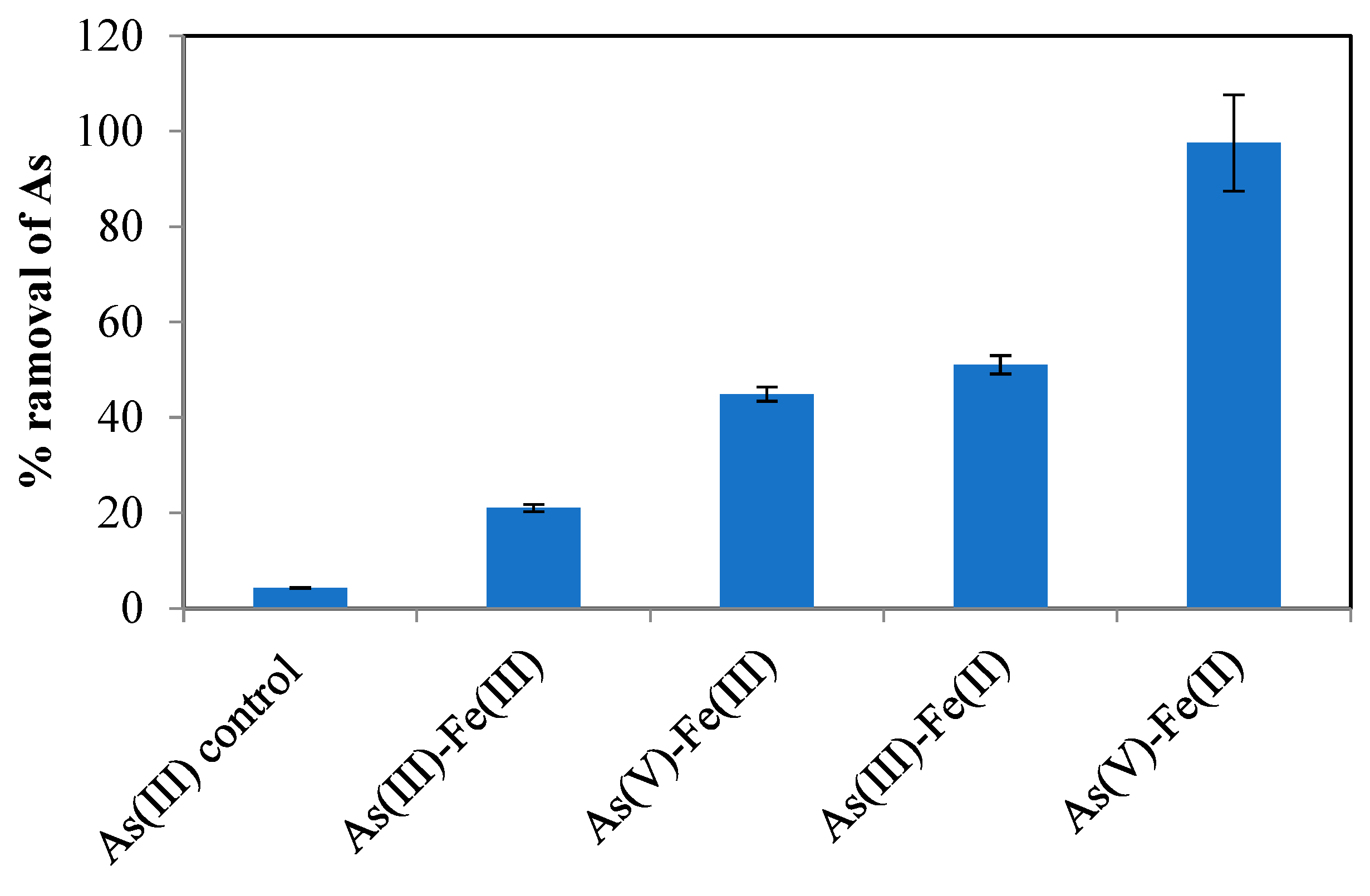
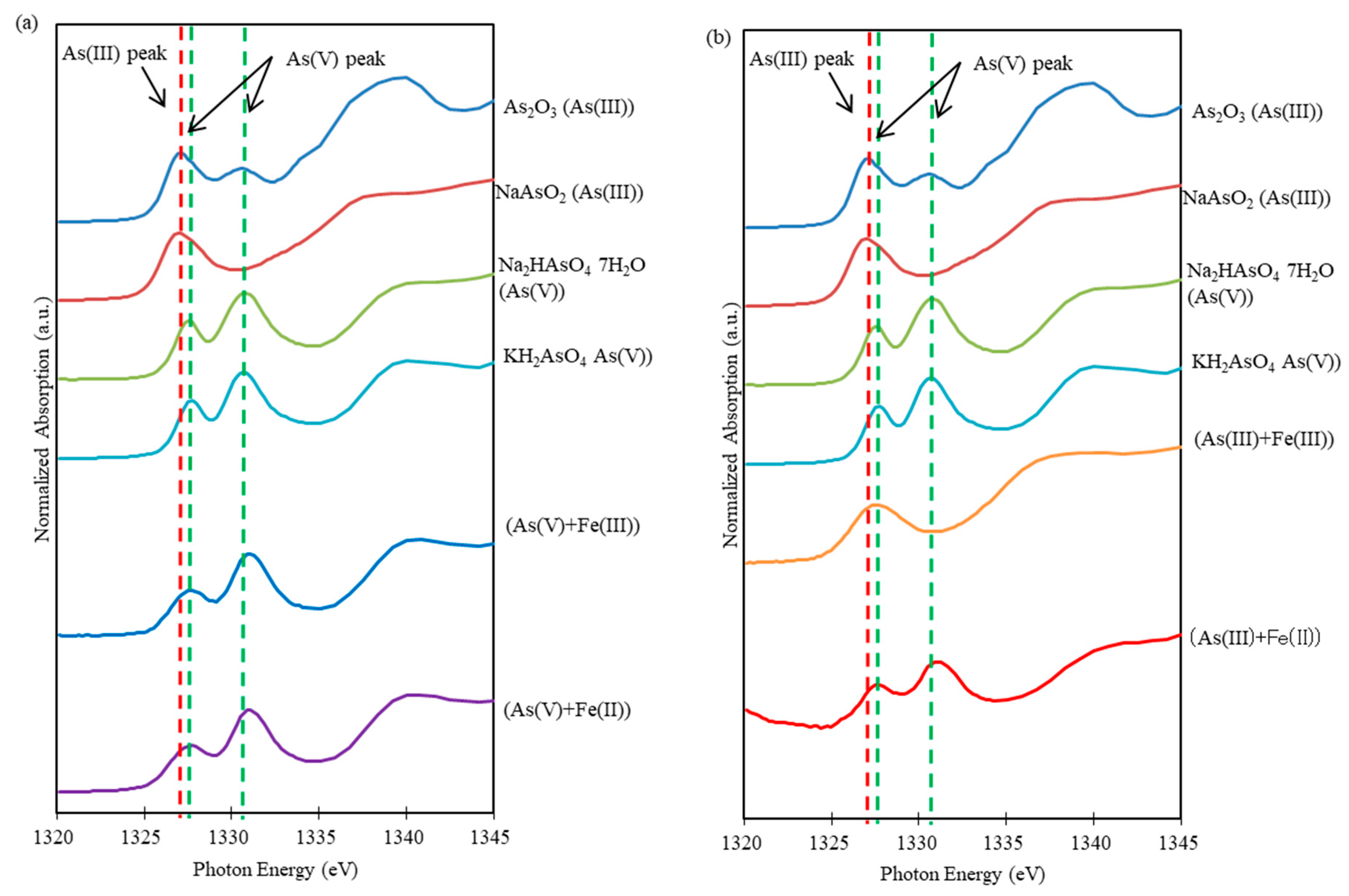
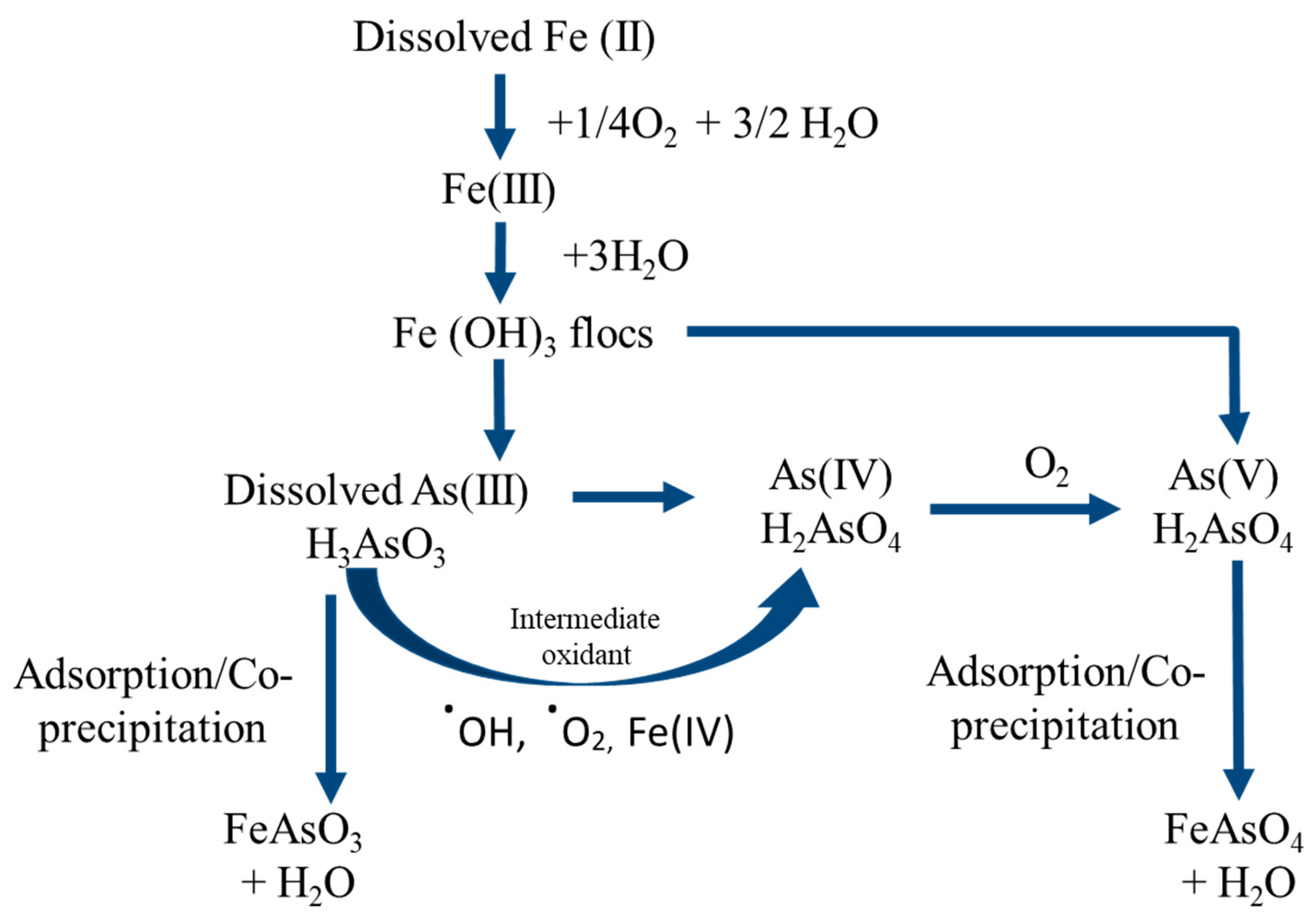
| Parameters | Unit | Concentrations | |
|---|---|---|---|
| * Synthetic Groundwater | Groundwater Used for Five Clay Filters | ||
| pH | - | 7.1–7.2 | 6.9–7.5 |
| Eh | mV | 138 | 90–141 |
| DO | mg/L | 6.0–6.5 | 2.5–2.9 |
| As | µg/L | 500 | 110–220 |
| Fe | mg/L | 5–20 | 2.2–14.5 |
| Si | mg/L | 20 | 16.9–24.1 |
| Mn | mg/L | 0.45 | 0.09–0.23 |
| Ca+ | mg/L | 100 | 112–170 |
| Mg+ | mg/L | 40 | 39–47 |
| PO4-P | mg/L | 1.0 | 1.2–2.3 |
| SO4− | mg/L | 200 | - |
| Hardness (as HCO3−) | mg/L | 350 | 400–450 |
| Exp. Name | As(III) (µg/L) | As(V) (µg/L) | Fe(II) (mg/L) | Fe(III) (mg/L) |
|---|---|---|---|---|
| As(III)-control | 500 | - | - | - |
| As(III)-Fe(III) | 500 | - | - | 5.0 |
| As(V)-Fe(III) | - | 500 | - | 5.0 |
| As(III)-Fe(II) | 500 | - | 5.0 | - |
| As(V)-Fe(II) | - | 500 | 5.0 | - |
| Parameters | Equipment Used |
|---|---|
| pH, Eh, and EC | HORIBA-D-54S pH meter, HORIBA, Osaka, Japan |
| Dissolved oxygen (DO) | HACH-HQ30d DO meter, HACH, Tokyo, Japan |
| Hardness (as HCO3−) | AQUACHECK-ECO test strips, AQUACHECK, Loveland, CO, USA |
| As * | Inductively coupled plasma mass spectrometry (ICP-MS), Yokogawa, HP 4500, Hewlett-Packard, Tokyo, Japan |
| Fe *, Mn *, Ca *, Mg *, and Si * | ICP spectrometry (ICP-AES), Seiko SPS 4000, Tokyo, Japan |
| Sulfate, SO4− * | HQ 30d UV spectrophotometer, Shimadzu, Kyoto, Japan |
| Phosphorus as PO4-P * | HQ 30d UV spectrophotometer, Shimadzu, Kyoto, Japan |
| As (µg/L) | Fe (mg/L) | Fe/As (mol/mol) | ||||||
|---|---|---|---|---|---|---|---|---|
| Influent | Effluent | Removal % | Removal | Influent | Effluent | Removal % | ||
| Filter #1 | 220 | 64 | 70.9 | 156 | 14.45 | 0.21 | 98.5 | 49.0 |
| Filter #2 | 160 | 85 | 46.9 | 75 | 4.4 | 0.25 | 94.3 | 20.5 |
| Filter #3 | 140 | 38 | 72.9 | 102 | 10.35 | 0.13 | 98.7 | 55.2 |
| Filter #4 | 110 | 102 | 7.3 | 8 | 2.28 | 0.11 | 95.2 | 15.5 |
| Filter #5 | 125 | 25 | 80.0 | 100 | 6.5 | 0.11 | 98.3 | 38.8 |
Disclaimer/Publisher’s Note: The statements, opinions and data contained in all publications are solely those of the individual author(s) and contributor(s) and not of MDPI and/or the editor(s). MDPI and/or the editor(s) disclaim responsibility for any injury to people or property resulting from any ideas, methods, instructions or products referred to in the content. |
© 2023 by the authors. Licensee MDPI, Basel, Switzerland. This article is an open access article distributed under the terms and conditions of the Creative Commons Attribution (CC BY) license (https://creativecommons.org/licenses/by/4.0/).
Share and Cite
Shafiquzzaman, M.; Ahsan, A.; Hasan, M.M.; Ahmed, A.T.; Bari, Q.H. The Role of Naturally Occurring Fe(II) in Removing Arsenic from Groundwater: Batch Experiments and Field Studies. Water 2023, 15, 4081. https://doi.org/10.3390/w15234081
Shafiquzzaman M, Ahsan A, Hasan MM, Ahmed AT, Bari QH. The Role of Naturally Occurring Fe(II) in Removing Arsenic from Groundwater: Batch Experiments and Field Studies. Water. 2023; 15(23):4081. https://doi.org/10.3390/w15234081
Chicago/Turabian StyleShafiquzzaman, Md., Amimul Ahsan, Md. Mahmudul Hasan, Abdelkader T. Ahmed, and Quazi Hamidul Bari. 2023. "The Role of Naturally Occurring Fe(II) in Removing Arsenic from Groundwater: Batch Experiments and Field Studies" Water 15, no. 23: 4081. https://doi.org/10.3390/w15234081
APA StyleShafiquzzaman, M., Ahsan, A., Hasan, M. M., Ahmed, A. T., & Bari, Q. H. (2023). The Role of Naturally Occurring Fe(II) in Removing Arsenic from Groundwater: Batch Experiments and Field Studies. Water, 15(23), 4081. https://doi.org/10.3390/w15234081









